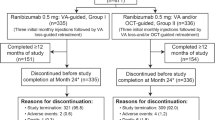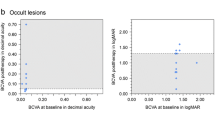Abstract
The use of intravitreal ranibizumab in exudative age-related macular degeneration (eAMD) has become commonplace. We aim to investigate the early predictors of this treatment outcome. Seventy-one treatment-naive eyes of 71 patients with eAMD of all lesion subtypes who received intravitreal ranibizumab treatment and completed 12 months of follow-up were included. All patients were loaded with three injections of ranibizumab at monthly intervals. Further injections were given if clinically indicated based on logMAR best-corrected visual acuity (BCVA) and optical coherence tomography findings. Casenotes of eligible patients were reviewed retrospectively. The main outcome measure was logMAR BCVA change at month 12. The mean number of injections given over 12 months was 5.4 ± 1.9. A total of 88.7 % of the patients achieved visual stabilisation (loss of <15 letters) and 15.0 % achieved visual improvement (gain of ≥15 letters). The mean letter change at 12 months was +0.3 letters. Regression analysis showed that baseline BCVA and letter change at month 3 predicted visual acuity outcome at month 12 (baseline BCVA: t = 6.97, p < 0.001; letter change: t = 5.84, p < 0.01) but age, gender and eAMD in the fellow eye were not predictive. Finally, a decisional answer tree model demonstrated that letter change at month 3 was a strong predictor of visual outcome at month 12 with an overall accuracy of 69 %. We found that letter change from baseline at month 3 was strongly predictive of visual outcome at month 12.



Similar content being viewed by others
References
Bressler NM (2004) Age-related macular degeneration is the leading cause of blindness. JAMA 291:1900–1901
Do DV (2009) Antiangiogenic approaches to age-related macular degeneration in the future. Ophthalmology 116:S24–S26
Heier JS, Antoszyk AN, Pavan PR, Leff SR, Rosenfeld PJ (2006) Ranibizumab for treatment of neovascular age-related macular degeneration: a phase I/II multicenter, controlled, multidose study. Ophthalmology 113(633):e1–e4
Brown DM, Kaiser PK, Michels M, Soubrane G, Heier JS et al (2006) Ranibizumab versus verteporfin for neovascular age-related macular degeneration. N Engl J Med 355:1432–1444
Brown DM, Michels M, Kaiser PK, Heier JS, Sy JP et al (2009) Ranibizumab versus verteporfin photodynamic therapy for neovascular age-related macular degeneration: two-year results of the ANCHOR study. Ophthalmology 116(57–65):e5
Rosenfeld PJ, Brown DM, Heier JS, Boyer DS, Kaiser PK et al (2006) Ranibizumab for neovascular age-related macular degeneration. N Engl J Med 355:1419–1431
Regillo CD, Brown DM, Abraham P, Yue H, Ianchulev T et al (2008) Randomized, double-masked, sham-controlled trial of ranibizumab for neovascular age-related macular degeneration: PIER study year 1. Am J Ophthalmol 145:239–248
Lalwani GA, Rosenfeld PJ, Fung AE, Dubovy SR, Michels S et al. (2009) A variable-dosing regimen with intravitreal ranibizumab for neovascular age-related macular degeneration: year 2 of the PrONTO study. Am J Ophthalmol 148:43–58.e1
Brown MM, Brown GC, Brown HC, Peet J (2008) A value-based medicine analysis of ranibizumab for the treatment of subfoveal neovascular macular degeneration. Ophthalmology 115(1039–45):e5
Fletcher EC, Lade RJ, Adewoyin T, Chong NV (2008) Computerized model of cost–utility analysis for treatment of age-related macular degeneration. Ophthalmology 115:2192–2198
Cohen SY, Bremond-Gignac D, Quentel G, Mimoun G, Citterio T et al (2008) Cost-effectiveness sequential modeling of ranibizumab versus usual care in age-related macular degeneration. Graefes Arch Clin Exp Ophthalmol 246:1527–1534
NICE (2008) Pegaptanib and ranibizumab for the treatment of age-related macular degeneration. National Institute for Health and Clinical Excellence (NICE) guideline
Cohen SY, Dubois L, Tadayoni R, Fajnkuchen F, Nghiem-Buffet S et al (2009) Results of one-year’s treatment with ranibizumab for exudative age-related macular degeneration in a clinical setting. Am J Ophthalmol 148:409–413
Boyer DS, Antoszyk AN, Awh CC, Bhisitkul RB, Shapiro H et al (2007) Subgroup analysis of the MARINA study of ranibizumab in neovascular age-related macular degeneration. Ophthalmology 114:246–252
Kaiser PK, Brown DM, Zhang K, Hudson HL, Holz FG et al (2007) Ranibizumab for predominantly classic neovascular age-related macular degeneration: subgroup analysis of first-year ANCHOR results. Am J Ophthalmol 2007(144):850–857
Kang S, Roh YJ (2009) One-year results of intravitreal ranibizumab for neovascular age-related macular degeneration and clinical responses of various subgroups. Jpn J Ophthalmol 53:389–395
Bloch SB, IaCour M, Sander B, Hansen LK, Fuchs J et al. (2011) Predictors of 1-year visual outcome in neovascular age-related macular degeneration following intravitreal ranibizumab treatment. Acta Ophthalmol. doi:10.1111/j.1755-3768.2011.02268.x
Menghini M, Kurz-Levin MM, Amstutz C, Michels S, Windisch R et al (2010) Response to ranibizumab therapy in neovascular AMD—an evaluation of good and bad responders. Klin Monbl Augenheilkd 227:244–248
Bolz M, Simader C, Ritter M, Ahlers C, Benesch T et al (2010) Morphological and functional analysis of the loading regimen with intravitreal ranibizumab in neovascular AMD. Br J Ophthalmol 94:185–189
Author information
Authors and Affiliations
Corresponding author
Rights and permissions
About this article
Cite this article
Tan, S.Z., Laude, A., Aspinall, P.A. et al. Decisional answer tree analysis of exudative age-related macular degeneration treatment outcomes. Int Ophthalmol 33, 467–474 (2013). https://doi.org/10.1007/s10792-013-9717-7
Received:
Accepted:
Published:
Issue Date:
DOI: https://doi.org/10.1007/s10792-013-9717-7




